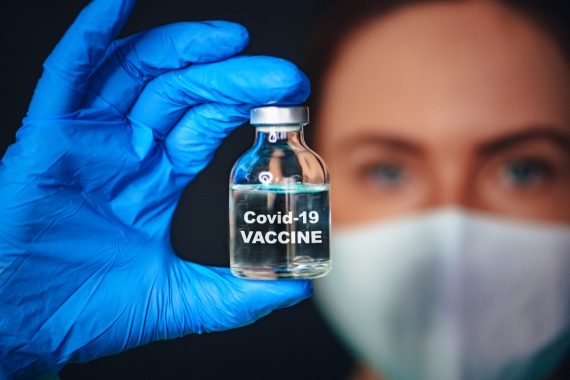PCN groupings can now move supply of the Oxford vaccine around individual GP practices, NHS England has said.
The vaccine can also be moved ‘flexibly’ to care homes and housebound patients, it added.
An NHS England letter sent to practices last night said this comes as the ‘characteristics of the AZ vaccine make it comparatively easier to deploy and handle’.
The letter said: ‘Providing the cold chain of 2-8ºC and other conditions as set out in the relevant Standard Operating Procedures are maintained at all times prior to administration, it is permissible in principle for PCN groupings to transport the AZ vaccine flexibly between practice sites within the PCN grouping as well as to care homes and to those patients who are housebound and require vaccination at home.’
It added that the vaccine can be moved ‘several times’ as long as the cold chain is ‘assured and maintained’.
NHS England said: ‘However, the vaccine should not be transported once the first dose has been removed from the vial.
‘There should be no returns to stock and the vaccine must never be returned to the PCN refrigerator after it has left the PCN site for administration elsewhere (where it must either be administered or destroyed).’
PCN groupings should only administer vaccines from places other than the designated site ‘where it is considered that this will improve patient access or increase vaccination capacity – which remains a prime consideration’ – it added.
Vaccine moved to other sites must be used ‘as soon as it is received’ and not stored and there must be a ‘robust system’ for maintaining the cold chain. GPs must record any movement of the vaccine, as well as any wastage.
The letter outlined that there will be ‘no change to current PCN grouping set-up and supply arrangements’ and practices must continue to meet all the requirements of the service specification.
This means that:
- All vaccines, consumables and equipment will continue to be delivered to designated sites ‘only’ so PCNs will have to transport them to any alternative premises;
- New Pinnacle/Outcomes for Health accounts will not be set up so all vaccinations must be recorded against lead practice codes;
- The entire PCN grouping that is sub-contracting vaccine delivery ‘will at all times retain responsibility for governance and control of the vaccines’;
- PCNs will need to ensure alternative premises comply with all requirements and guidance;
- No wholesale dealer’s licence is necessary for vaccine sharing, subject to compliance with the service specification.
NHS England added that care homes remain the ‘priority setting’ for delivery of the Oxford vaccine and that all PCNs should ‘maximise use’ in their care homes ‘as it arrives’.
The flexibility applies only to the Oxford vaccine and conditions for delivery of the Pfizer vaccine remain unchanged.
Meanwhile, an NHS England email bulletin sent to practices yesterday evening confirmed that the programme was ‘initially focusing on sites that can deliver high volumes’.
It said: ‘This is in part because of the nature of both vaccines and the logistics needed, but also because we need to prioritise where we can get high numbers of people vaccinated quickly.
‘As we rapidly roll out the programme further, we are looking at other delivery models.’
And Prime Minister Boris Johnson yesterday outlined the vaccination programme’s progress in a press conference.
There will be over 1,000 GP-led sites providing vaccines, 223 hospital sites, seven giant vaccination centres and a first wave of 200 community pharmacies ‘by the end of next week’, he said.
He added: ‘If all goes well, these together should have the capacity to deliver hundreds of thousands of vaccines per day by 15 January and it is our plan that everyone should have a vaccination available within a radius of ten miles.
‘And it follows from that that the limits will not be on our distributional power but on the supply of vaccines.’
Mr Johnson said he has ‘no doubt’ there is both ‘enough supply’ and the ‘distributional network’ to vaccinate the JCVI’s first four priority groups by the Government’s 15 February deadline – and to continue expansion of the programme.
However, he warned that there will be ‘difficulties’, including the changing of appointments, and that the challenge ‘will require an unprecedented national effort’.
To date, he said, 1.5 million people have been vaccinated across the UK.
This week, it was revealed that GPs do not need to observe patients for 15 minutes after administering the Oxford vaccine and that they may be able to extract an additional dose from vials.
Pulse October survey
Take our July 2025 survey to potentially win £1.000 worth of tokens














we are keen to get cracking on our vulnerable patients – we just need the vaccines so hopefully they will start arriving soon.
NHS England said: ‘However, the vaccine should not be transported once the first dose has been removed from the vial.
Erm, so how do we administer this to housebound individuals that live alone if we have to drive to the next address?
Ignore them, unless they can tell you a logical reason for this.
Echo that Monica. Central Command making it up as they go along as usual, simply irritating background noise…
Given this announcement, there is absolutely no reason why this now has to be done “at scale”. Unless it’s ideological, of course…..